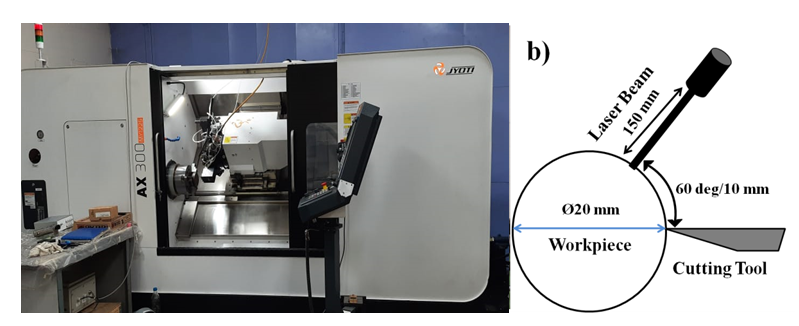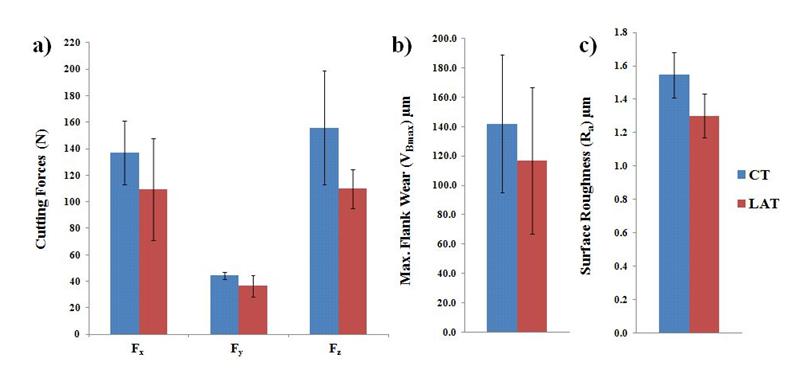An innovative laser-assisted machining technique developed by scientists recently can enhance the cutting performance of Nickel-based superalloy 625 as compared to conventional machining. This improvement can help reduce cutting force, delay wear and tear, and decrease the surface roughness of the resulting machines.
High-temperature nickel-based superalloys find widespread applications in various industries, ranging from aerospace and chemical to nuclear as well as in power production systems, such as boilers, heat exchanger tubes, and steam turbines. These materials are prized for their exceptional hardness, resistance to high temperatures, corrosion resistance, superior high-temperature mechanical properties, and prolonged durability compared to conventional metals. However, these properties that make superalloys so valuable also make them exceptionally challenging to machines using conventional methods rendering them uneconomical. The challenge is even more because of the high precision they demand.
Scientists at International Advanced Research Centre for Powder Metallurgy and New Materials (ARCI), an autonomous institution under Department of Science and Technology, have successfully addressed the machining challenge through the development of a custom-built laser-assisted machining technology tailored for hard-to-machine materials.
The project, supported under the Clean Coal R&D Program of the DST, aims to develop a laser-assisted machining process for Nickel-based superalloys and comparing its performance with conventional methods.

Fig. 1: Laser-Assisted Machining facility at ARCI and Laser-assisted turning Schematic
The team used a hybrid cutting process in which a focused laser beam was utilised to heat local areas of the work piece and remove softened material from the ductile region. The innovative system integrated a fiber-coupled diode laser. It also included a piezo-electric dynamometer for precise cutting force measurements and a high-speed pyrometer to measure surface temperature during machining. The addition of a 5-axis universal fixture enhances the system's flexibility in positioning the laser for the cutting tool.
In this innovative approach, the laser was harnessed to soften the superalloy material, typically exceeding 800°C for Nickel-based superalloys, rendering it more ductile and easier to machine. This helped avoid distortion in the material, which is important for dimensional accuracy.
The uniqueness of this technique lies in the precise control over the laser's position and strength, ensuring it only heats a small, targeted portion of the material just before the machining process. The softened material was then quickly removed by a cutting tool, preventing any heat-induced damage to the material's interior.
The team compared cutting force, machined surface quality, and tool wear of laser-assisted machining of Nickel-based superalloy 625 with normal machining. The findings published in the journal Lasers Manuf. Mater. Process. indicated that laser-assisted machining significantly enhances the cutting performance of IN625 when compared to conventional machining. This improvement is evident in reduced cutting force, delayed tool wear, and decreased surface roughness.
The study underscores the substantial potential of laser-assisted machining in enhancing the cutting performance of IN625. Moreover, the laser-assisted machining process contributes to energy savings by reducing cutting force, making it green machining.

Fig. 2: Comparison of responses in conventional and laser-assisted turning, a) Cutting forces, b) Maximum flank wear (VBmax), c) Surface roughness (Ra)
This advanced laser-assisted machining process represents a critical step forward in the quest for more efficient and cost-effective methods to fabricate precision components from hard-to-machine materials. It could lead to cost reduction in the power sector, increased efficiency in the aeroengine industry, and cost-effective machining in the chemical and nuclear sector.
The ongoing research and experimentation conducted by the ARCI team provides foundation for the future development and refinement of this innovative machining technique.
Publication:
Publication Link: https://doi.org/10.1007/s40516-023-00230-9
For more details contact Dr. Ravi Bathe (ravi[at]arci[dot]res[dot]in)






























